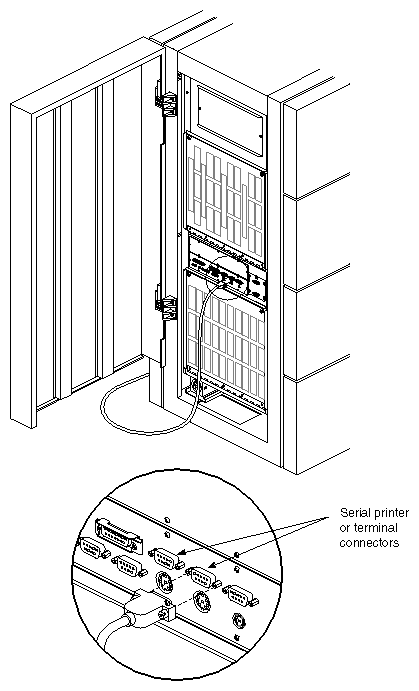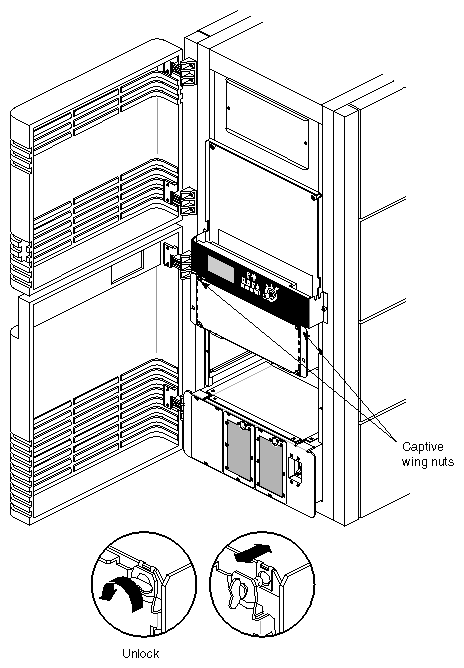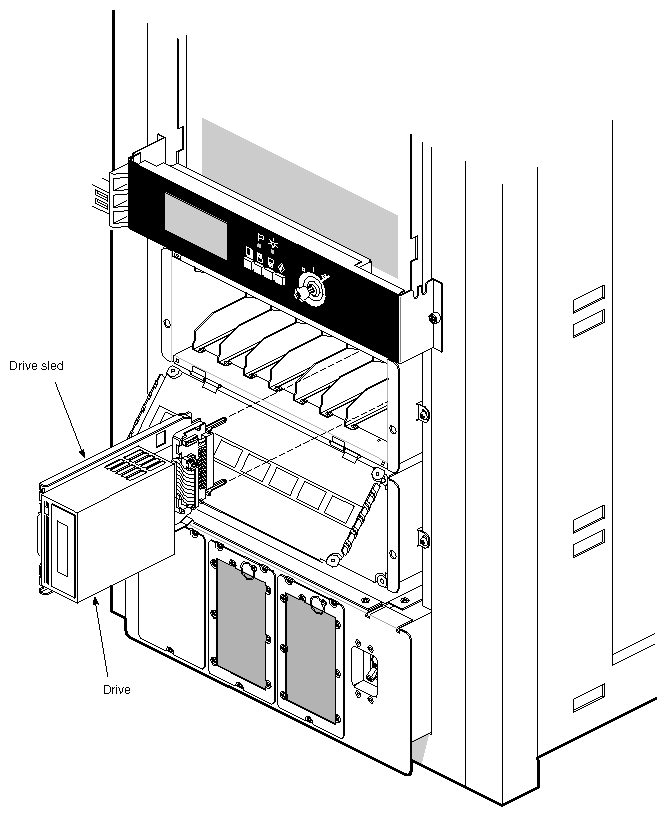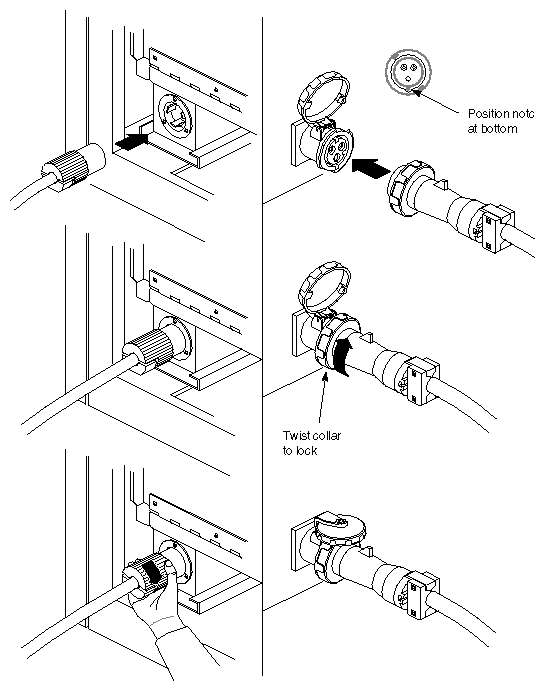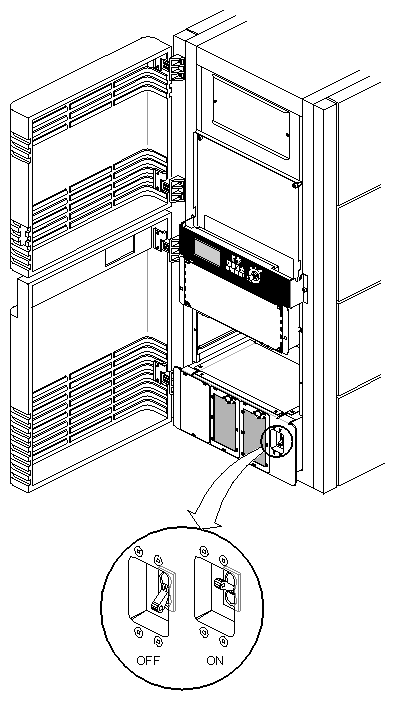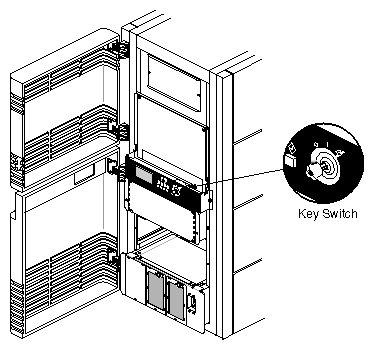This chapter describes the procedures you should use to configure and operate your Challenge server correctly.
| Warning: The Challenge rackmount server operates on 220-400 VAC. Use extreme caution when working around this voltage. Never install or remove power cords without first turning off the equipment. 48 VDC is present on the system midplane. This voltage is present even if the system has been reset or halted. |
Customer maintenance is limited to the outside of the chassis, which comprises the peripherals and cables attached to the I/O panel. No user-serviceable parts are found within the chassis.
| Note: This product requires the use of external shielded cables in order to maintain compliance with Part 15 of the FCC rules. |
The Challenge rackmount server requires a customer-supplied American Standard Code for Information Interchange (ASCII) terminal. Note the following caution before attempting to connect your terminal.
| Caution: Before plugging the terminal into either a 120 VAC or a 250 VAC outlet, be sure that the electrical rating on the UL-CSA label is in either the 100–120 VAC or the 200–240 VAC range, whichever applies. |
| Note: When using a terminal in locations that do not have either a 120 VAC or a 250 VAC outlet, contact your Silicon Graphics system support engineer before plugging in the terminal power cable. Use only the specified cable to connect the terminal to the system chassis. |
An ASCII terminal uses a simple null modem cable with a 9-pin connector at one end and a 25-pin connector at the other. See Table 3-1 for the pin assignments for the two connectors.
Table 3-1. 25-Pin Terminal Connector Pin Assignments
25-Pin (DB-25) Connector | 9-Pin (DB-9) Connector at Challenge | Signal Description at Challenge |
|---|---|---|
3 | 2 | Transmitted Data (TXD) |
7 | 7 | Signal Ground (GND) |
2 | 3 | Received Data (RXD) |
| Note: This product requires the use of external shielded cables in order to maintain compliance with Part 15 of the FCC rules. Serial cables from different vendors are not compatible. Verify the pinout of your cable before making the connection. |
Use the following procedure to connect the ASCII terminal to your system:
Open the lower front door of the system chassis and verify that the system power switch, located in the lower right corner, is off.
Make sure that the power switch on the terminal is turned off and that the power cord is not connected to an outlet.
Attach the end of the terminal cable with the 25-pin connector to the corresponding connector at the rear of the terminal.
Open the rear door of the chassis to expose the main I/O panel.
Attach the end of the cable with the 9-pin D-sub connector to the serial connector labeled “tty 1” on the main I/O panel, as shown in Figure 3-1.
Ensure that the terminal cable is routed through the cutout in the bottom of the access door and that it is not pinched or kinked when the door is shut.
Attach the terminal power cord to the rear of the terminal and to the appropriate power source.
Refer to the IRIX Advanced Site and Server Administration Guide for more information about configuring your terminal.
All Challenge rackmount systems are configured with a minimum of two fully independent SCSI channels provided by the IO4 board. In its maximum configuration, with the addition of multiple SCSI mezzanine boards, the Challenge server system can have 48 SCSI channels. A portion of these channels can be configured as either single-ended or differential SCSI.
The difference between single-ended and differential SCSI channels is defined as follows: a single-ended SCSI channel pairs each signal line with a ground line. A differential SCSI channel pairs each signal line with a second signal that is the balanced inverse of the first. This configuration makes differential SCSI less susceptible to signal degradation due to noise and more suitable for remote (longer) cabling.
The internal and external SCSI buses can be configured as either single-ended or differential. Generally, internal buses are configured as single-ended, and external buses that connect to remote storage devices are differential. The requirements and limitations of both single-ended and differential SCSI buses are described below.
The maximum allowable length for single-ended (standard) SCSI cabling is 19.6 feet (6 meters). This maximum length reflects the combined lengths of both the internal and external cables. A single-ended SCSI bus can support a maximum of eight SCSI devices (including the SCSI controller board).
The maximum allowable length for differential SCSI is 80 feet (25 meters). As with single-ended SCSI, this length is the sum of both the internal and external cables. A differential SCSI bus can support a maximum of 16 devices (including the controller board).
| Note: The most common reason for SCSI device failure is insufficient noise margins due to exceeding the maximum cable length, cable impedance mismatches, or both. If you are having trouble with certain devices, particularly external devices, be sure to verify that you have not exceeded the maximum SCSI cable length. |
Always use shortest cable possible. Route external cables away from potential damage due to foot traffic, cleaning, and so on.
If you have additional questions about SCSI connections and cable lengths, contact your Silicon Graphics representative.
SCSI channels must be terminated at both the IO4 board (or S mezz board) and at the last device on the channel. The internal SCSI channels (in the SCSIBoxes) are configured so that front loading devices (FLDs) can be added or removed without affecting the channel termination; however, if devices are being added or removed from an external SCSI bus, you must verify that the correct external channel termination is maintained.
| Caution: Single-ended and differential SCSI buses must be terminated with single-ended and differential terminators, respectively. Terminating a bus with the wrong terminator can cause system damage. |
| Note: All installed IO4 boards and/or S mezz boards are terminated at the time of installation. Do not attempt to open the cardcages to verify channel termination. |
This section describes the physical installation and removal of an FLD (front loading device) from the Challenge server. It is assumed that the server has already been configured for the drives being removed or installed.
| Note: If the FLD is not configured, refer to Chapter 4, “Installing and Using Optional Peripherals,” for configuration instructions. |
Install an FLD in the SCSIBox drive enclosure as follows:
Ensure that the system power is not turned on. If the system is running, refer to “Powering Off the System” later in this chapter.
Open the lower front access door of the system chassis.
Release the two captive wing nuts securing the SCSIBox door and allow the door to swing down (see Figure 3-2).
Orient the FLD relative to the SCSIBox so that the drive is facing toward the right (see Figure 3-3).
Select a vacant drive bay and carefully align the rails on the drive sled with the corresponding rails in the drive bay.
Slide the FLD into the bay until the locking mechanism is engaged and the locking lever on the drive sled moves down to the locked position. Push the lever down to ensure that it is fully engaged.

Note: If the FLD is being installed for the first time, ensure that the drive is not terminated. Verify that the device ID was not accidently changed during the installation.
Close the SCSIBox door and secure the captive wing nuts.
Power on the system as described in the following section.
Close the lower front access door of the system chassis.
See the IRIX Advanced Site and Server Administration Guide for the information needed to configure the software.
Remove an FLD from the SCSIBox as follows:
The Challenge rackmount server comes with a 15-pin AUI Ethernet connector. You can order optional boards for additional Ethernet connections.
Power on the Challenge rackmount server as follows:
Verify that the system power switch, located in the lower front corner of the system chassis, is turned off.
Insert the female end of the system power cable into the receptacle at the rear of the system chassis (see Figure 3-4). Secure the cable by turning the connector clockwise to engage the twist lock.
Connect the male end of the power cable to an AC power source using the appropriate receptacle. Your system has either a keyed connector with a locking collar or a twist-lock connector. Turn the locking collar on the keyed connector clockwise to engage the locating tabs on the AC outlet. Turn the twist-lock connector clockwise to secure it to the AC outlet.
Refer to the Challenge/Onyx Site Preparation Guide for the system's power requirements.

Warning: The Challenge rackmount server operates on 220-400 VAC. Use extreme caution when working around this voltage. Never install or remove power cords without first turning off the equipment. If the terminal and peripherals are equipped with voltage select switches, verify that they are set for the appropriate AC voltage.
Connect the power cords from the terminal and any additional peripherals to the appropriate three-pronged grounded outlets.
Turn on the system power switch (see Figure 3-5).
Turn on the terminal, followed by any attached peripherals (for example, a printer).

Note: All internal storage devices are automatically powered on by the System Controller Boot the system according to the following section.
Boot your system by performing the following steps:
Power on the system, as described in the preceding section.
Open the lower front door to the system chassis.
Insert the key into the key switch, located to the right of the System Controller's display (see Figure 3-6).
Turn the key switch to the On position.
The System Controller begins the power-on sequence. The green power-on LED, located above the function buttons, lights up to indicate that power has been applied to the system midplane. The amber fault LED then lights up to indicate that power has been supplied to the System Controller. The fault LED goes out when the System Controller has successfully initialized and the power-on tests have completed.
After the bootmaster CPU has been selected, the system's progress can be monitored on the System Controller's display. Use the function buttons to select the Boot Status menu, and a series of status messages are displayed during a normal boot cycle (see Table 3-2).

Note: Do not press any of the front panel buttons until the “Boot Arbitration is Complete” message is displayed by the System Controller. Pressing the buttons before the bootmaster CPU is identified aborts the boot arbitration process. When the power-on tests have completed, you see this message: Starting up the system...
To perform System Maintenance instead, press <Esc>.
Table 3-2. System Controller Boot Status Messages
Boot Status Message
Message Description
BOOT ARBITRATION NOT STARTED
The system CPU boards have not begun the arbitration process.
BOOT ARBITRATION IN PROCESS
The system CPU boards are communicating to decide which one will be the bootmaster CPU.
BOOT ARBITRATION IS COMPLETE SLOT #xx PROC #yy
The chosen CPU has identified itself to the System Controller, and communication is fully established.
To reconfigure your system or to list your system's hardware, press <Esc> within five seconds.

Note: If you don't press <Esc> within five seconds, the system will come up and display the desktop. If this happens, log in, shut down the system using the “System Shutdown” command from the System Maintenance menu, and then restart it when prompted. When the System Maintenance menu appears, type 5 to select “Enter Command Monitor.”
When the >> prompt appears, type hinv, then press <Enter> to display the hardware inventory of your system.

Note: See the IRIX Advanced Site and Server Administration Guide for information on reconfiguring your system. The System Maintenance menu reappears. Type 1 to select the “Start System” command. The system comes completely up.
The basic IRIX® operating system is factory-installed on your system disk. No software installation is required. If additional software is desired, it must be downloaded either locally (using a CD player) or downloaded remotely, over the network. See the IRIX Advanced Site and Server Administration Guide for additional information about mounting and configuring drives. Refer to the IRIS Software Installation Guide for the steps required to download the software.
| Note: A copy of the IRIX operating system is supplied with the system on a compact disc (1/4-inch tape can be special-ordered). Place the CD or tapes in a secure place in case you ever need to reinstall the operating system. |
The system should be powered off only for routine maintenance or repair. Power your system off as follows:
Become superuser by typing /bin/su and pressing <Enter>.
Enter your superuser password, if prompted.
When the superuser prompt (#) appears, type /etc/shutdown and press <Enter>.
A message similar to the following appears on the screen:
Okay to power off the system now. Press any key to restart.
Open the lower front access door, insert the key in the key switch, and turn the key switch to the Off position.
Turn off the power switches for the system and the peripherals in the following order:
Printer (if installed)
Terminal
System chassis

Note: Before you power off the server, be sure to inform all of the server's clients in advance.
Reset your system by turning the key switch, next to the System Controller function buttons, to the Manager position. Use the scroll buttons to bring up the Reset menu. Press the Menu button to activate the menu, then press the Execute button to reset the system. Use only the Reset function, not the main power switch, to reboot your system if the system is completely unresponsive. If your system responds to input, use the halt command.
